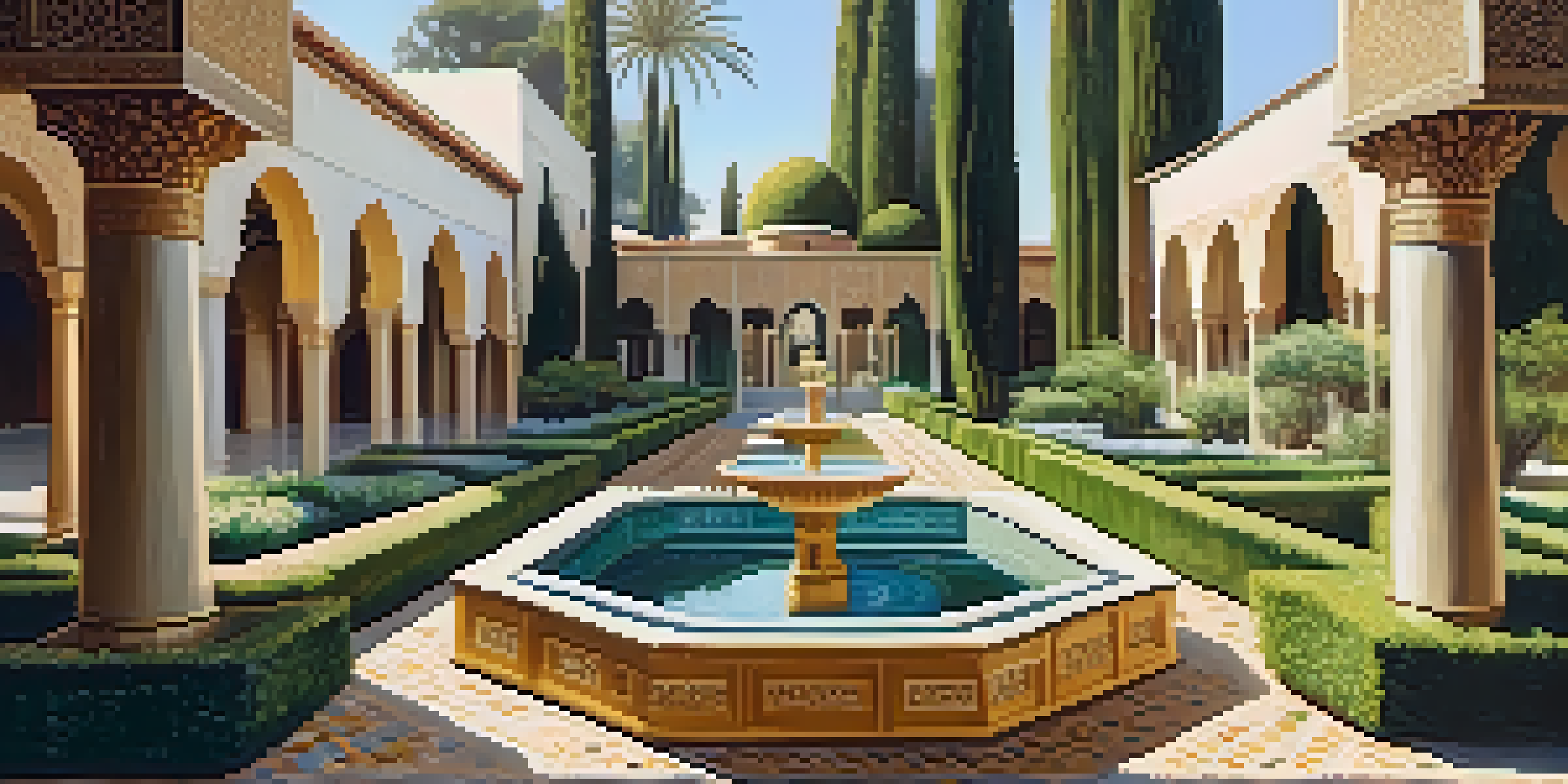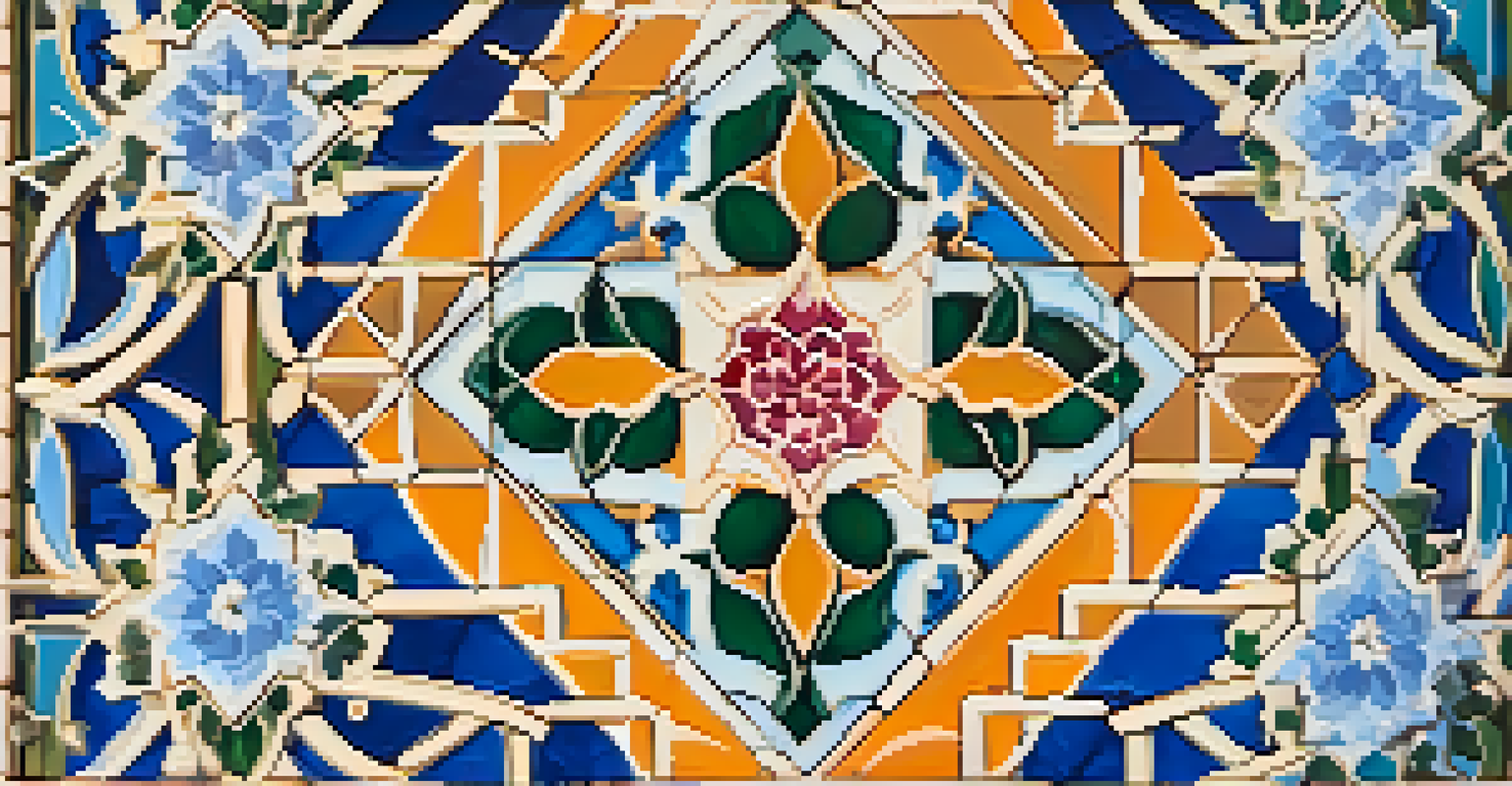The Influence of Islamic Culture in Spanish Garden Design

Introduction to Islamic Influence in Spanish Gardens
The gardens of Spain are a beautiful testament to the rich history of Islamic culture. During the Moorish occupation from the 8th to the 15th centuries, the integration of Islamic design principles introduced a unique aesthetic to Spanish landscapes. This blending of cultures resulted in gardens that are not only visually stunning but also deeply symbolic and functional.
Gardens are a form of autobiography.
Islamic gardens are often characterized by their emphasis on tranquility and nature, featuring elements like water, shade, and intricate designs. When these elements were introduced in Spain, they transformed the traditional European garden into a more serene and contemplative space. The influence can still be seen today in many Spanish gardens that follow these age-old principles.
As we explore the various aspects of Islamic influence in Spanish garden design, we will uncover how these elements continue to inspire modern landscaping and gardening practices. The interplay between culture and nature creates gardens that tell a story, inviting us to appreciate their beauty and significance.
Key Elements of Islamic Garden Design
One of the most striking features of Islamic garden design is the use of water as a central element. Water symbolizes life and paradise in Islamic culture, often represented through fountains, pools, and channels. In Spanish gardens, this concept manifested as elaborate waterworks, creating a refreshing atmosphere that invites relaxation and contemplation.

Another essential aspect is the incorporation of geometric patterns and symmetry. Islamic gardens are often laid out in a grid-like structure, which not only organizes the space but also reflects a sense of harmony and balance. This design principle can be observed in famous Spanish gardens, such as the Alhambra, where intricate tile work and patterned pathways guide visitors through lush greenery.
Islamic Gardens Emphasize Water
Water plays a crucial role in Islamic gardens, symbolizing life and paradise while creating serene and refreshing spaces.
Finally, the use of plants in Islamic gardens is very deliberate, focusing on flora that offers shade, fragrance, and beauty. Common plants include citrus trees, roses, and jasmine, which thrive in the Spanish climate. These elements come together to create a sensory experience that enchants visitors and connects them to the natural world.
Symbolism in Islamic Gardens
In Islamic culture, gardens are not just about aesthetics; they are rich with symbolism. The four-part garden layout, known as a 'chahar bagh,' represents the four rivers of paradise mentioned in the Quran. This layout has influenced many Spanish gardens, providing a sense of spiritual grounding and connection to nature.
To plant a garden is to believe in tomorrow.
Additionally, the use of plants and flowers often carries deeper meanings. For example, the rose symbolizes love and beauty, while the cypress tree represents death and immortality. In Spanish gardens, these symbols are interwoven into the landscape, offering visitors more than just a visual treat; they provide a narrative that resonates with cultural and historical significance.
By understanding the symbolism behind these gardens, we gain insight into the values and beliefs of the cultures that created them. This connection to heritage enriches our experience of these gardens, making each visit a journey through time and tradition.
Famous Islamic-Inspired Gardens in Spain
One of the most iconic examples of Islamic-inspired gardens in Spain is the Generalife in Granada. This summer palace of the Nasrid rulers features beautifully landscaped gardens that showcase the principles of symmetry, water, and the lushness typical of Islamic design. As you stroll through its pathways, you can’t help but feel a sense of peace and harmony.
Another notable garden is the Alcázar of Seville, which boasts a rich history and stunning Moorish architecture. The gardens here are an exquisite blend of Islamic and Renaissance styles, filled with fountains, orange trees, and intricate tile work. Each corner of the garden presents a new perspective, drawing visitors into its enchanting atmosphere.
Symbolism Shapes Garden Design
The layout and plant choices in Islamic gardens are rich with symbolism, reflecting deeper cultural and spiritual meanings.
Lastly, the Royal Gardens of the Alcazaba in Almería illustrate the practicality of Islamic garden design. These gardens were not only beautiful but also functional, providing food and shade. This blend of utility and aesthetics continues to inspire modern garden designs throughout Spain and beyond.
The Role of Water in Islamic Gardens
Water is often considered the lifeblood of Islamic gardens, serving both aesthetic and practical purposes. In the arid climates of Spain, the presence of water creates a refreshing oasis, providing a contrast to the surrounding landscape. Fountains and reflecting pools not only enhance beauty but also create soothing sounds that encourage relaxation.
The strategic placement of water features is integral to the experience of an Islamic garden. It draws the eye and invites visitors to explore further, much like a gentle stream leading you through a forest. In Spanish gardens, this principle is evident, with water channels often guiding visitors from one section to another, creating a sense of flow and continuity.
Moreover, the use of water in Islamic gardens symbolizes purity and life, reflecting the importance of nature in spiritual practices. This connection emphasizes the harmony between man and the environment, a theme that resonates strongly in the design of many Spanish gardens today.
Modern Interpretations of Islamic Garden Design
As we move into the 21st century, the influence of Islamic garden design continues to thrive in modern landscaping practices. Contemporary designers often draw inspiration from traditional elements, incorporating water features, geometric patterns, and carefully curated plant selections to create tranquil spaces. This modern twist keeps the essence of Islamic gardens alive while adapting to current trends.
Today's gardens often emphasize sustainability and environmental stewardship, values that align closely with traditional Islamic principles. By using native plants and water-efficient landscaping, modern gardens can reflect the beauty of Islamic design while promoting ecological health. This approach not only honors the past but also paves the way for future generations.
Modern Gardens Embrace Tradition
Contemporary landscaping draws inspiration from Islamic garden principles, blending aesthetic beauty with sustainability and community focus.
Moreover, public spaces are increasingly recognizing the value of creating gardens that foster community and connection. By integrating Islamic design elements, these spaces can offer a serene retreat from the hustle and bustle of urban life, encouraging reflection and social interaction. Thus, the legacy of Islamic garden design continues to flourish in contemporary society.
Conclusion: The Lasting Legacy of Islamic Gardens
The influence of Islamic culture on Spanish garden design is profound and enduring. By blending aesthetics, symbolism, and practicality, these gardens have created spaces that resonate with visitors on multiple levels. They offer a glimpse into the past while providing a sanctuary for relaxation and contemplation.
As we appreciate the beauty of these gardens, it's essential to recognize the cultural exchanges that have shaped them. The harmonious blend of Islamic and Spanish elements reflects a rich history of interaction and understanding, showcasing the power of nature to unite diverse cultures.

In conclusion, the legacy of Islamic gardens in Spain serves as a reminder of the importance of nature in our lives. Whether you’re wandering through the lush pathways of the Alhambra or enjoying a quiet moment in a local park, the influence of Islamic design principles continues to inspire and enrich our experiences in the world of gardening.